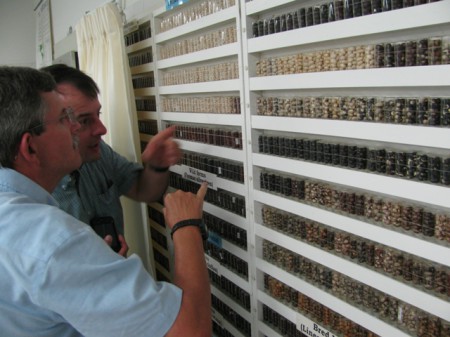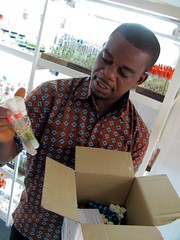- Impact of landscape alteration and invasions on pollinators: a meta-analysis. Habitat alteration and invasions equally bad on visitation rates, invasive animals more bad than invasive plants, and disturbance of the matrix more than fragment size. But there are some differences among vegetation types.
- The determinants of leaf turgor loss point and prediction of drought tolerance of species and biomes: a global meta-analysis. Osmotic potential at full turgor could be used to predict drought tolerance across species. Cut a long story short, that simplifies down to salty cell sap, give or take. Good for choosing crop wild relatives to use in breeding for drought tolerance?
- Market-based instruments for biodiversity and ecosystem services: A lexicon. If you want to tell your tradable permits from your reverse auctions. And really, who doesn’t?
- Phenotypic and molecular dissection of ICRISAT mini core collection of peanut (Arachis hypogaea L.) for high oleic acid. Much diversity in oleic acid (O) to low linoleic acid (L) ratio found. Breeders alerted.
- Phenotypic diversity and evolution of farmer varieties of bread wheat on organic farms in Europe. There wasn’t much of it, over 3 years.
- A Comparison of Dung Beetle (Coleoptera: Scarabaeidae) Attraction to Native and Exotic Mammal Dung. They really know their shit.
- Small-scale farming in semi-arid areas: Livelihood dynamics between 1997 and 2010 in Laikipia, Kenya. Life continues to be a bitch, there’s no other way to say it. But when will the people who measure livelihoods measure the diversity of people’s assets as well as their size?
- Climate-associated phenological advances in bee pollinators and bee-pollinated plants. About 10 days over the past 130 years, most of the change since 1970, and bee plants keeping pace with bees.
Nibbles: All singing and dancing, FAO meets Big Data, Clone this, Patent nonsense, Frozen fish
- Fisherfolk of the Amazon landed on film. But do they sing about it? (And it’s not just an Amazon thing, this dancing and singing about agrobiodiversity. Not by any means.) And should they be doing more slashing-and-burning?
- FAO to put all its data in one basket. But including AnGR? WIEWS? One asks more in hope than expectation.
- One of the many challenges of vegetatively propagated crops (like potatoes): rapid multiplication. (Well, they could always do an SNP-based tetraploid map of the damn things, couldn’t they.) No such problems with seeds, of course.
- There’s been a rapid increase in the patenting of adaptation-related traits, and the private sector in industrialized countries is mainly responsible. Well there’s a surprise. But was that discussed at the CCAFS meeting on breeding objectives for Africa? And it’s just as well to remember that it’s not just breeding that’s needed. Oh, but by the way, you better grab those adaptations while you can…
- Regional SE Asian fish genebank proposed. That I’d love to see. Maybe they could share germplasm with, I dunno, Chicago? And not just.
Ready for safety duplication
A glass vial of beans is worth a thousand database entries
Check out one of the illustrations in Brainpicking’s review of a recent book on the Academy of Natural Sciences of Philadelphia (“which stands today as the oldest natural history museum in the Western Hemisphere,” and just celebrated its 200th anniversary). It’s the one labelled “Agricultural seed samples collected by Charles F. Kuenne, 1948,” towards the bottom of the page. I’m trying to find out who Mr Kuenne was. Or is. He’s not mentioned in GRIN, alas. But what I wanted to talk about was the sort of glass jars that he — and many others — used to store and display his seeds.
I always thought they were pretty useless, as you can virtually guarantee that the seeds will be dead in short order stored like that. Of course keeping them alive was not the point, and you can now extract DNA from much worse samples. But the fact of the matter is it that during last week’s trip to the CIAT genebank I saw bean breeders look at the assembled ranks of little grain-filled vials on display there so longingly, and lovingly, I cannot but revise my opinion.

Who needs fancy databases when you can just run your eyes past thousands of different bean samples in a few seconds? Having said that, if you search the CIAT database you will find the varieties Red Valentine (G07707) and Rust Proof Golden Wax (G09523) collected by Kuenne — though not his actual samples, of course. They’re in Philadelphia.
Nibbles: Genomic data, Seed porn, Ancient Amazonian ag, Genebanks Down Under, Climate data porn, Fiber in Maine, REDD+ at the CBD, Colony Collapse Disorder, Chili porn, Seed systems
- GBIF makes its move.
- Homaging the seed.
- Learning sustainability from old Amazonian farmers. Really old. Really, really old.
- Yet another Aussie genebank. Or maybe the same one, I’ve lost track. And interest.
- Where climate data comes from.
- Maine’s fiber community, what, exposed? Unveiled? Uncovered? And similar from Bolivia.
- REDD+ will save us all.
- Don’t crack open the mead to celebrate the solution to colony collapse disorder just yet.
- All things Capsicum on one handy website.
- Whole bunch of policy briefs on African seed systems. Don’t know if I’ll ever have the time to read through the lot, but cursory perusal suggests the following bottom line: the market can’t do it all by itself.
